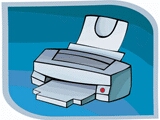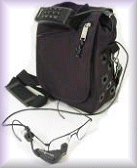What is a computer?
(adapted by Sandro
L. Sousa from www.cambridge.org/elt/infotech, 2003)
A. Read the text and study the diagram.
|
Computers are electronic machines which can accept data in a certain form, process the data and give the results of the processing in a specified format as information. Three basic steps are involved in the process. First, data is fed into the computer's memory. Then, when the program is run, the computer performs a set of instructions and processes the data. Finally, we can see the results (the output) on the screen or in printed form (see the diagram below). Information in the form of data and programs is known as software, and the electronic and mechanical parts that make up a computer system are called hardware. A standard computer system consists of three main sections: the central processing unit (CPU), the main memory and the peripherals. Perhaps the most influential component is the central processing unit. Its function is to execute program instructions and coordinate the activities of all the other units. In a way, it is the 'brain' of the computer. The main memory holds instructions and data which are currently being processed by the CPU. The peripherals are the physical units attached to the computer. They include storage devices and input/output devices. Storage devices (floppy, hard or optical disks) provide a permanent storage of both data and programs. Disk drives are used to handle one or more floppy disks. Input devices enable data to go into the computer's memory. The most common input devices are the mouse and the keyboard. Output devices enable us to extract the finished product from the system. For example, the computer shows the output on the monitor or prints the results onto paper by means of a printer. On the rear panel of the computer there are several ports into which we can plug a wide range of peripherals — modems, fax machines, optical drives and scanners. These are the main physical units of a computer system, generally known as the configuration. |
Input ![]() Processor
Processor
![]() Output
Output
Expenses
(e.g. payroll, services, publicity)
Income (e.g. sales, stocks, interest)
![]()

![]()

Data Processing Result
Language Work: The Passive.
A passiva é geralmente usada para descrever um processo (process): série de ações desempenhadas numa determinada ordem, para que um determinado resultado seja alcançado. Segundo Oliveira (1999), a maioria das coisas que fazemos é baseada em processos, tais como: configurar sua nova impressora, adicionar um novo aplicativo, utilizar o correio eletrônico. Neste tipo de orações, o mais importante é o resultado do processo e não quem o praticou.
|
The Passive The passive is formed with the verb
to be in the correct tense and past participle
of the main verb. (Future) (Modal) (Present Perfect) Remember: Regular
verbs end in –ed in the past participle. Em geral, os processos são descritos seguindo uma ordem cronológica marcada por “linking words” (conectivos) que indicam tempo e enumeração (first, then, after that, next, when, while, finally, lastly). Ex. First, data is fed into the computer's memory. Click here to watch a video teaching you how to pronounce 50 (fifty) of the most common irregular verbs. |
B. Encontre no texto 04 orações que usam, a passiva para descrever processos.
C. Now, visit this website and answer theses exercises about passive tenses: Passive Tenses.
D. Look at the box help and then complete these sentences with a suitable verb
form.
a. COBOL (use)
E. Use the information in the text
and diagram to help you match the terms in the box with the appropriate explanation
or definitionv below. a. software b. peripheral
devices c. monitor d. floppy disk e.
hardware
F. Read these slogans or quotations, and say what computer element they refer to.
Can you image wearing a PC on your belt and getting
e-mail on your eyeglasses? Wearable computers are battery-operated systems
worn on the user's body - on a belt, backpack or vest and are designed
for mobile or hands-free operation, often incorporating a microphone
and a head-mounted display. Some devices are waist-mounted, equipped with a wireless
modem, a keypad and a small screen. Others are voice-activated, worn
like a scarf and can access e-mail or voice mail. Users of wearable technology consider themselves 'cyborgs'.
This term comes from 'cybernetic organism', referring to a being that
is part robot, part human. HELP
Box e.g. blue-eyed girl
= a girl who has got blue eyes A. Translate
these phrases into Portuguese. HELP
Box e.g.
The American computer company Microsoft is making new computers
every year. Em
inglês, é comum se juntar substantivos em cadeia: bus
stop, teapot, storage devices. É possível, também,
observar duas ordens: uma mais extensa, parecida com português,
e outra curta. A. Write the short form on the left
as in the example.
b. Original programs (write)
in a high-level language.
c. All computer languages (must translate)
into binary commands.
d. The ADA language (develop)
in 1979.
e. In the 1970s, new languages such as LISP and PROLOG (design)
for research into Artificial Intelligence.
f. A new version of TurboPascal (release)
just
.
g. In the next century, computers (program)
in language such as English or French.
f. input g. port h.output i. central processing
unit
1. The brain of the computer
2. Physical parts that make up a computer system
3. Programs which can be used on a particular computer
system
4. The information which is presented to the computer
5. Results produced by a computer
6. Hardware equipment attached to the CPU
7. Visual display unit
8. Small device used to store information. Same as 'diskette'
9. Any socket or channel in a computer system into which
an input/output device maybe connected.
![]()
Text 02: Wearable computers,
aren't they chic?

Grammar Focus 1: Compound Adjectives
Um adjetivo composto é feito
com duas ou mais partes. É muito comum que esses elementos venham
seguidos por hífen, sendo que o elemento da direita é
sempre o núcleo da nova palavra formada. A segunda parte freqüentemente
contém um particípio passado ou presente.
sugar-free
product = a product that uses no sugar
Grammar Focus 2: Word order
and Phrase Composition
A ordem das palavras
muitas vezes é diferente em inglês em
comparação com o português. Por isso, devemos evitar
a leitura e tradução de textos
palavra por palavra. É mais indicado ler o texto
como um todo.
(A
americana computador companhia Microsoft está fazendo novos computadores
todos os anos!).
1.
Computer company 2.
A company which makes computers.
A concrete pavement.
= a pavement made of concrete.
= the exposition in Paris.
= property of the church.
= the sheet of plastic.
= a chip made of silicon.
= books about hardware.
= a company making radios with transistors in them.
= a worker doing research in Hardware.
= The Department of Computing of the University of Rio
Grande do Norte.
= mail using voice.
= devices which store data.
= studies of the communications used by animals.
Extra Activity: Charmed Technology
A. Enter the site http://www.charmed.com/
and give the name of product the company announces.
B. Now, say what the purpose of the product is. (Diga qual é o propósito do produto).
Alternative site: The MIT Wearable Computing Web Page: http://www.media.mit.edu/wearables
-
B. Match the words in column A with their Portuguese meanings in column B.
a. Ethernet que se pode permutar, trocar; b. Core feixe, lote; c. Add-on núcleo, parte condutora central de um cabo; d. Dual viabilidade e. Bundle suplementar, adicional; f. Swappable usando dois ou um par; g. Feasibility forma de rede área local onde o dado é transmitido em pacotes de comprimento variável;